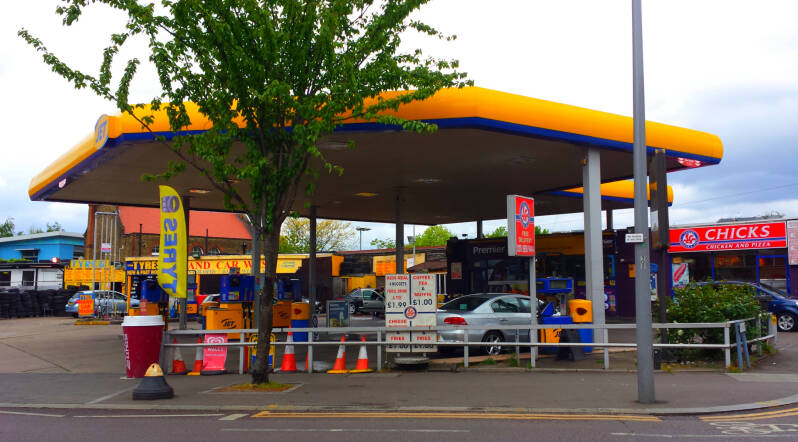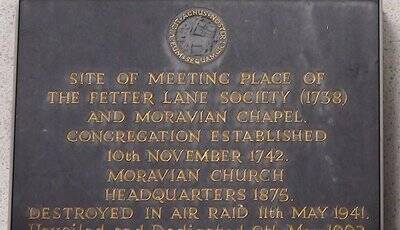LEYTON to LEYTONSTONE to WANSTEAD


Option 1
Langthorne Road

Option 2
Grove Green Road

Option 1
FETTER LANE CONGREGATIONAL CHAPEL
Church and Sunday school.
1899. Arch. P.MORLEY HORDER. Roughcast and stone dressings, in an ARTS AND CRAFTS manner. Gabled west with flush mullioned Serbian windows . Buttresses. Segmental reveals around upper windows, windows segmental headed/square. Mullioned in timber/stone
ST.PATRICK’S CEMETERY
Final resting place of around 170.000 RC EASTENDERS oblivious of the CENTRAL LINE trains clattering between LEY and LEY’ONE. With ST.MARY’S KENSAL GREEN, the 2 RC ONLY cemeteries in GL.
Open in 1968. The demand was growing. Villages were swallowed by the growing metropolis.
A diverse range of communities, nations and languages, but mostly IRISH and ITALIANS.
A landscape packed with graves, with only a few trees and plants in between. Not like the classical Victorian cemeteries, landscaped and laid out with the dual purpose of being burial grounds and gardens.
Still in use. Soil has been piled on top of unmarked graves, to provide extra space.
Due to natural shifs of the ground son monuments have been toppled
FERRARI MAUSOLEUM
An unusual, concrete modernist structure that stands out. 1965. LUCIA FERRARY, “mamma adorabile”. Stained glass window.
ST.PATRICK
In bishops robes, holding a shamrock (metaphor of the Holy Trinity). A serpent coils around staff (the legend says that ST.PATRICK drove all snakes out
SAN ANDREA
Patron saint of AMALFI
German inscription
English/French inscription
A mixed couple
OUR LADY OF SORROWS
Female with the heart pierced by 7daggers, that is the 7 soeeows of the life of Mar
GRAVE OF ANN MCSWEENEY
A grave packed with symbols of love and devotion, friendship, faithfulness : clasped hands joined by ribbon, Ivy, roses, lilies (virtue and purity), metal knots around edges of the grave (marriage)
LOSSES OF WAE
V1, BLITZ, SOMME, flying accident
MARY KELLY STONE
Buried originally in a paupers grave, unmarked. Today, a small stone

Resting place of 5 members of his family, amongst them parents and sister.
LANGTHORNE PARK.
Mosaic &Screen
STUART HALE
Open Air Arena
Rounders
Totem Pole
ROBERT KOENIG
Blue Sculture
SITE OF WORKHOUSE
In former farmland, property of STRATFORD LANGTHORNE ABBEY, b. 1840. Opened 1842.
Ts heaped main building build. 3 storeys. With lower wings to the rear. 2 courtyards, for men and women.
GF offices. FF, Master and Matron quarters, and dormitories. 2F Lying wards. In the rear wing, dining room, storerooms. Mint hen in the basement.
Enlarged in 1845. In 1864 an INFIRMARY b. to the West.
In 1870 a BOARD ROOM, West, now Mental Health, and STORES East, now part of Thorne Centre..
In 1930 control passed tomWEST HAM BC, renaming it CENTRAL HOME PUBLIC ASSISTANCE INSTITUTION, a home for the chronically ill, the aged, the inform. In 1938 it had 1.800 beds.
During WW2 part of EMERGENCY MEDICAL SERVICES. SIR CLAUDE FRANK (part of contingency plans, as the gov. had anticipated that 100.000 tons of bombs would be dropped on London during the first fortnight of the war, and a quarter of a million casualties, in LDN and the HOME COUNTIES).
1948.LANGTHORNE HOSPITAL, part of the NHS, specialised in geriatric care, with 831 beds for chronic sock, 475 for aged residents.
Upgraded and improved, the QUEEN MOTHER visited in ‘57, and in ‘60 the DUKE OF KEN5 opened a geriatric new wing. In ‘65 a SOCIAL CENTRE opened by DOWAGER MARCHIONNESS OF READING. WRVS Chairman.
In 1974, reorganisation: placed under the new authority, the NETH RH Auth. In ‘82 WF HEALTH auth. In ‘99, LOSED
CHAPEL
M-F doorways.
CHURCH OF THE HOLY TRINITY W/ST.AGUSTINE OF HIPPO
Sculptures over the door

MAYVILLE ROAD PRIMARY
Young Alfred first attended Mayville Road School, Leytonstone (now Mayville Primary School), but his parents were told off by Father Flannagan for sending him to a secular school
This was a factor contributing to Hitchcock's sense of isolation: religion. The Hitchcocks were Catholics, while most of their neighbours were Protestants."
Leytonstone High Road

No. 517
Birthplace of SIR ALFRED HITCHCOCK

13 Aug 1899, above the family’, greengrocerks shop. The family moved here in 1896. A row of 10 houses, recently build, after the housing boom 1880s-1900 (from fields and farms to packed terrace housing).
By 1904 they hat a telephone: WANSTEAD 569. Identified as “W” (William, his father) and “fruiterer”. The business was flourishing, supplying smaller shops and general stores with fruits and vegetables. They had another shop across the road.
”behind, ripening sheds, great bunches of bananas ripening by the warmth of gas flares. Smell. A bit older he went out, all day! with deliveries all over the area, by horse-drawn van. walnuts delivered in the outer coats and husked “ A.HITCH recalls the electric trams running down the HIGH ROAD. The maiden journey started in December 1906.
The family moved to SALMON LANE, LIMEHOUSE (between 1906 and 1908]. By 1911 ED.HEN. MICKELOROUGH run the business here (his wife was related to the HTCH).
517 was part of larger single property according to a 1951 map. By the 80s, demolished.
WF Plaque 1994
"Frenzy" is centered around Covent Garden Market, an area Hitchcock, the son of a greengrocer, would have been familiar with as a child. The market scenes were mostly filmed during the last weeks of July 1971.
After Bob Rusk invites Babs Milligan back to his flat, the pair walk through the Flower Market building in a single 75-second shot filmed on July 30th, 1971.
Pub sign of the Loaded Dog Public House. This picture is probably based on a 19th century story from Wales with the same title, telling how a miner tried out an easy way to catch a lot of fish. He threw a stick of dynamite into a river expecting the explosion to kill or stun the fish. However, his faithful but dim dog dashed in and retrieved it, returning with a wagging tail and the dynamite in its mouth. The dog's tail did not wag much longer. The term was also used on greyhound race tracks, where dogs were sometimes loaded with weights to lose, as opposed to loaded dice which were tampered with to win.

The HITCHCOCK children: Cycling alongside the HIGH ROAD
His early life appears to be somewhat solitary. Being several years younger than his brother and sister he was often not allowed to join them.
"This is shown by his early memory of them refusing to let him go with them on a bicycle ride to the Green Man (at the top of Leytonstone High Road) as he was too young...
GIANT’S HEAD and other artworks
In the Acacia Road Play Park on the corner of Montague Road and Acacia Road. The head is about two metres high and was constructed at the Eden Project in Cornwall. He originally had green grass hair and two eyes. But the grass died during a hot summer and one eye was damaged so now winks. There are other interesting artworks in play park. Look out for mosaics, some beautiful wrought iron gates and a cement path decorated by childrens' hand prints.
Sea Bass
Harrow Road. A 10 metre long boat labelled Sea Bass in the play area in Harrow Road Park. Two slides have been fixed and a mock canon pokes out of one side. There is a series of sculptures with marine themes on the ground in front of its bow
The Birds

2013. Mural by ATEUSZ OBROBNY with ANNA MILL

HARROW GREEN POLICE STATION

Hitchcock was terrified of authority - policemen in particular. As recounted by François Truffaut in his ‘Definitive Study of Alfred Hitchcock’: “I must have been about four or five years old when my father sent me to the Police Station with a note. The Chief of Police read it and locked me in a cell for five or ten minutes, saying, ‘This is what we do to naughty boys.’ … I haven’t the faintest idea why I was punished. As a matter of fact, my father used to call me his ‘little lamb without a spot,’ so I truly cannot imagine what I did …” It is apparent that William Hitchcock was a strict disciplinarian, instilling the lifelong sense of guilt and fear of the police that underscore his son’s films. The site of Harrow Rd Police Station opposite Harrow Green is now occupied by a Costcutter shop.
WAR MEMORIAL

TO THE GLORY OF GOD. / IN HONOUR OF THOSE WHO SERVED. / IN SYMPATHY WITH THOSE WHO SUFFERED / AND / IN PROUD AND GRATEFUL REMEMBRANCE / OF THE MEN OF / LEYTON AND LEYTONSTONE / WHO FELL IN THE GREAT WARS / 1914 - 1918 - 1939 - 1945
CANN HALL

A ward within WF. Former civil parish, first inc in LEYTON Urb.Sanit.Distr, and afterwards in the Parish of WANSTEAD)
HUGH DE MONTFORD, LORD OF MONTFORD-SUR-ISLE, Norman noble, companion of W.CONQ., listed as landowner here in DB.
His daughter ADELA gave the holding to the CANONS of HOLY TRINITY ALDGATE, 1121. Thence the name of the manor,a contraction.
The farm was purchased by NICOLAS SYMPSON, owned by succ, until 1671, WILLIAM COLEGRAVE, and succ. until early 19th.By then, the tenants around the country estate were permitted to graze their livestock on WANSTEAD FLATS, owned by the Crown.
The COLEGRAVES fought with others against the FLATS being bought by private landowners. In 1851-52 part of thecFLATS were lost in a protracted legal battle, though later much of the land was saved for the public by thecCORP OF LDN.
By te 1860s farm buildings were on both sides of CANN HALL ROAD. To the N, farmland. In the 80s the land was sold for development. Names here are associated to the COLEGRAVES, who retained part until1900. PH name

Option 2
ESSEX HALL
TELEPHONE EXCHANGE
CHRISTIAN HOPE CHURCH
NORLINGTON RD FACTORY
PHILLYBROOK
CHURCH
SYNAGOGUE
LEYTONSTONE LU



Mosaics
ST.JOHN’S

THE RED LION PH

MARY FLETCHER


QUAKER


WANSTEAD HOUSE GATES
You can see SIR RICHARD CHILD monogram. He inherited the house in 1715 and was largely responsible for making it so palatial. His wealth derived from inheritance, as his father was Chairman of the E.I.C





Create Your Own Website With Webador